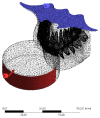Stress Concentration of Hybrid Occlusal Splint-Mouthguard during a Simulated Maxillofacial Traumatic Impact: 3D-FEA
- PMID: 35448059
- PMCID: PMC9029277
- DOI: 10.3390/dj10040065
Stress Concentration of Hybrid Occlusal Splint-Mouthguard during a Simulated Maxillofacial Traumatic Impact: 3D-FEA
Abstract
Mouthguards (MG) are protective devices that can reduce the risks of facial trauma. However, many athletes do not use them. Additionally, MG wear with coincidental parafunctional activity has not been considered. The aim of this study was to evaluate the stress distribution as a consequence of a direct impact comparing a conventional MG with a novel hybrid appliance (HMG). Using computer-aided design (CAD) software, a human skull was modeled with the teeth inserted into their respective alveolus. The models were divided according to the MG type (conventional or hybrid). The geometries were exported to the computer-aided engineering (CAE) software and the materials were considered isotropic. Fixation was defined at the base of the maxilla. The load was applied using a hockey puck. The total deformation (mm) and the von Mises stress (MPa) results were obtained for the MGs (conventional and hybrid), upper teeth, lower teeth, and maxillary bone. Despite the presence of an MG, it is still possible to observe generated stress in all structures. However, the hybrid design was more efficient than the conventional design in reducing the displacement during the impact and consequently the stress on the upper teeth, lower teeth, and maxillary bone. Higher stress magnitude was more concentrated at the inner portion of the hybrid design than the conventional device. The HMG appliance decreased the stress concentration in the teeth and in the bone, limiting the areas susceptible to injuries to the regions directly impacted by the hockey puck. Although the novel HMG may mitigate injury, some stress will still result, and any possible injury should be evaluated by a dental professional.
Keywords: athletic injuries; finite element analysis; mouthguard; occlusal splint; trauma.
Conflict of interest statement
The authors declare no conflict of interest.
Figures








Similar articles
-
Biomechanical Behavior Evaluation of a Novel Hybrid Occlusal Splint-Mouthguard for Contact Sports: 3D-FEA.Dent J (Basel). 2021 Dec 30;10(1):3. doi: 10.3390/dj10010003. Dent J (Basel). 2021. PMID: 35049601 Free PMC article.
-
The ability of mouthguards to protect veneered teeth: A 3D finite element analysis.Dent Traumatol. 2023 Jun;39(3):191-199. doi: 10.1111/edt.12812. Epub 2022 Dec 27. Dent Traumatol. 2023. PMID: 36573913
-
Influence of custom-made and stock mouthguard thickness on biomechanical response to a simulated impact.Dent Traumatol. 2018 Dec;34(6):429-437. doi: 10.1111/edt.12432. Epub 2018 Sep 21. Dent Traumatol. 2018. PMID: 30107079
-
Mouthguards in sport activities : history, physical properties and injury prevention effectiveness.Sports Med. 2007;37(2):117-44. doi: 10.2165/00007256-200737020-00003. Sports Med. 2007. PMID: 17241103 Review.
-
The Role of Mouthguards in Preventing and Reducing Sports-related Trauma.Prim Dent J. 2017 May 1;6(2):27-34. doi: 10.1308/205016817821281738. Prim Dent J. 2017. PMID: 28668098 Review.
Cited by
-
Comparison of Effectiveness of 2 mm Thick Mouthguard on Primary Central Incisor with and without Strip Crown Restoration: A Three-dimensional Finite Element Analysis.Int J Clin Pediatr Dent. 2025 Apr;18(4):363-367. doi: 10.5005/jp-journals-10005-3104. Epub 2025 May 19. Int J Clin Pediatr Dent. 2025. PMID: 40469824 Free PMC article.
-
Comparative Evaluation of Stress Distribution Pattern between Modified and Conventional Mouthguard on Maxillary Jaw when Standardized Forces are Applied Horizontally in a 14-year-old Child: A Three-dimensional Finite Element Analysis.Int J Clin Pediatr Dent. 2025 Jan;18(1):1-5. doi: 10.5005/jp-journals-10005-3031. Epub 2025 Feb 14. Int J Clin Pediatr Dent. 2025. PMID: 40110455 Free PMC article.
References
-
- Miró A., Buscà B., Aguilera-Castells J., Arboix-Alió J. Acute effects of wearing bite-aligning mouthguards on muscular strength, power, agility and quickness in a trained population: A systematic review. Int. J. Environ. Res. Public Health. 2021;18:6933. doi: 10.3390/ijerph18136933. - DOI - PMC - PubMed
-
- Tribst J.P.M., Dal Piva A.M.d.O., Borges A.L.S., Bottino M.A. Simulation of mouthguard use in preventing dental injuries caused by different impacts in sports activities. Sport Sci. Health. 2019;15:85–90. doi: 10.1007/s11332-018-0488-4. - DOI
LinkOut - more resources
Full Text Sources
Miscellaneous

